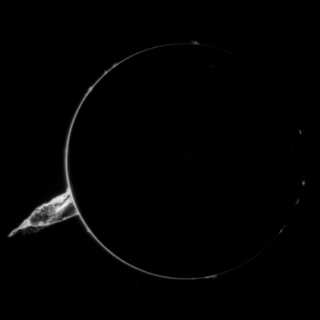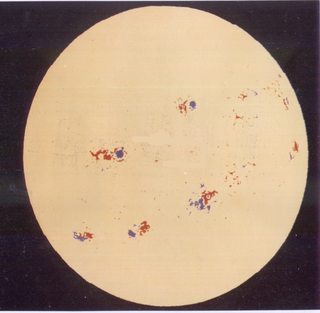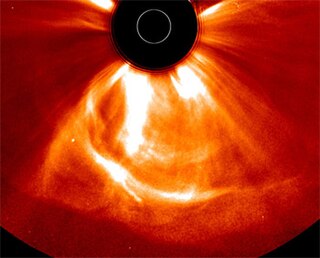
The solar wind is a stream of charged particles released from the Sun's outermost atmospheric layer, the corona. This plasma mostly consists of electrons, protons and alpha particles with kinetic energy between 0.5 and 10 keV. The composition of the solar wind plasma also includes a mixture of particle species found in the solar plasma: trace amounts of heavy ions and atomic nuclei of elements such as carbon, nitrogen, oxygen, neon, magnesium, silicon, sulfur, and iron. There are also rarer traces of some other nuclei and isotopes such as phosphorus, titanium, chromium, and nickel's isotopes 58Ni, 60Ni, and 62Ni. Superimposed with the solar-wind plasma is the interplanetary magnetic field. The solar wind varies in density, temperature and speed over time and over solar latitude and longitude. Its particles can escape the Sun's gravity because of their high energy resulting from the high temperature of the corona, which in turn is a result of the coronal magnetic field. The boundary separating the corona from the solar wind is called the Alfvén surface.

A solar flare is a relatively intense, localized emission of electromagnetic radiation in the Sun's atmosphere. Flares occur in active regions and are often, but not always, accompanied by coronal mass ejections, solar particle events, and other eruptive solar phenomena. The occurrence of solar flares varies with the 11-year solar cycle.

Space weather is a branch of space physics and aeronomy, or heliophysics, concerned with the varying conditions within the Solar System and its heliosphere. This includes the effects of the solar wind, especially on the Earth's magnetosphere, ionosphere, thermosphere, and exosphere. Though physically distinct, space weather is analogous to the terrestrial weather of Earth's atmosphere. The term "space weather" was first used in the 1950s and popularized in the 1990s. Later, it prompted research into "space climate", the large-scale and long-term patterns of space weather.

A geomagnetic storm, also known as a magnetic storm, is a temporary disturbance of the Earth's magnetosphere caused by a solar wind shock wave.

A coronal mass ejection (CME) is a significant ejection of plasma mass from the Sun's corona into the heliosphere. CMEs are often associated with solar flares and other forms of solar activity, but a broadly accepted theoretical understanding of these relationships has not been established.
A solar storm is a disturbance on the Sun, which can emanate outward across the heliosphere, affecting the entire Solar System, including Earth and its magnetosphere, and is the cause of space weather in the short-term with long-term patterns comprising space climate.

Coronal holes are regions of the Sun's corona that emit low levels of ultraviolet and X-ray radiation compared to their surroundings. They are composed of relatively cool and tenuous plasma permeated by magnetic fields that are open to interplanetary space. Compared to the corona's usual closed magnetic field that arches between regions of opposite magnetic polarity, the open magnetic field of a coronal hole allows solar wind to escape into space at a much quicker rate. This results in decreased temperature and density of the plasma at the site of a coronal hole, as well as an increased speed in the average solar wind measured in interplanetary space.

Solar cycle 24 is the most recently completed solar cycle, the 24th since 1755, when extensive recording of solar sunspot activity began. It began in December 2008 with a minimum smoothed sunspot number of 2.2, and ended in December 2019. Activity was minimal until early 2010. It reached its maximum in April 2014 with a 23 months smoothed sunspot number of 81.8. This maximum value was substantially lower than other recent solar cycles, down to a level which had not been seen since cycles 12 to 15 (1878-1923).

The Carrington Event was the most intense geomagnetic storm in recorded history, peaking on 1–2 September 1859 during solar cycle 10. It created strong auroral displays that were reported globally and caused sparking and even fires in telegraph stations. The geomagnetic storm was most likely the result of a coronal mass ejection (CME) from the Sun colliding with Earth's magnetosphere.

Solar cycle 10 was the tenth solar cycle since 1755, when extensive recording of solar sunspot activity began. The solar cycle lasted 11.3 years, beginning in December 1855 and ending in March 1867. The maximum smoothed sunspot number observed during the solar cycle was 186.2, and the starting minimum was 6.0. During the transit from solar cycle 10 to 11, there were a total of 406 days without sunspots.

Solar cycle 19 was the nineteenth solar cycle since 1755, when extensive recording of solar sunspot activity began. The solar cycle lasted 10.5 years, beginning in April 1954 and ending in October 1964. The International Geophysical Year occurred at the peak of this solar cycle.

Solar cycle 20 was the twentieth solar cycle since 1755, when extensive recording of solar sunspot activity began. The solar cycle lasted 11.4 years, beginning in October 1964 and ending in March 1976. The maximum smoothed sunspot number observed during the solar cycle was 156.6, and the starting minimum was 14.3. During the minimum transit from solar cycle 20 to 21, there were a total of 272 days with no sunspots.

Solar cycle 22 was the 22nd solar cycle since 1755, when extensive recording of solar sunspot activity began. The solar cycle lasted 9.9 years, beginning in September 1986 and ending in August 1996. The maximum smoothed sunspot number observed during the solar cycle was 212.5, and the starting minimum was 13.5. During the minimum transit from solar cycle 22 to 23, there were a total of 309 days with no sunspots.

The Bastille Day solar storm was a powerful solar storm on 14–16 July 2000 during the solar maximum of solar cycle 23. The storm began on the national day of France, Bastille Day. It involved a solar flare, a solar particle event, and a coronal mass ejection which caused a severe geomagnetic storm.

The solar storm of 2012 was a solar storm involving an unusually large and strong coronal mass ejection that occurred on July 23, 2012. It missed Earth by a margin of roughly nine days, as the Sun's equator rotates around its own axis once over a period of about 25 days.

Solar cycle 25 is the current solar cycle, the 25th since 1755, when extensive recording of solar sunspot activity began. It began in December 2019 with a minimum smoothed sunspot number of 1.8. It is expected to continue until about 2030.

Solar phenomena are natural phenomena which occur within the atmosphere of the Sun. They take many forms, including solar wind, radio wave flux, solar flares, coronal mass ejections, coronal heating and sunspots.

The solar storms of August 1972 were a historically powerful series of solar storms with intense to extreme solar flare, solar particle event, and geomagnetic storm components in early August 1972, during solar cycle 20. The storm caused widespread electric- and communication-grid disturbances through large portions of North America as well as satellite disruptions. On 4 August 1972 the storm caused the accidental detonation of numerous U.S. naval mines near Haiphong, North Vietnam. The coronal mass ejection (CME)'s transit time from the Sun to the Earth is the fastest ever recorded.

The solar storms of May 2024 were a series of powerful solar storms with extreme solar flares and geomagnetic storm components that occurred from 10–13 May 2024 during solar cycle 25. The geomagnetic storm was the most powerful to affect Earth since March 1989, and produced aurorae at far more equatorial latitudes than usual in both the Northern and Southern Hemispheres.


















